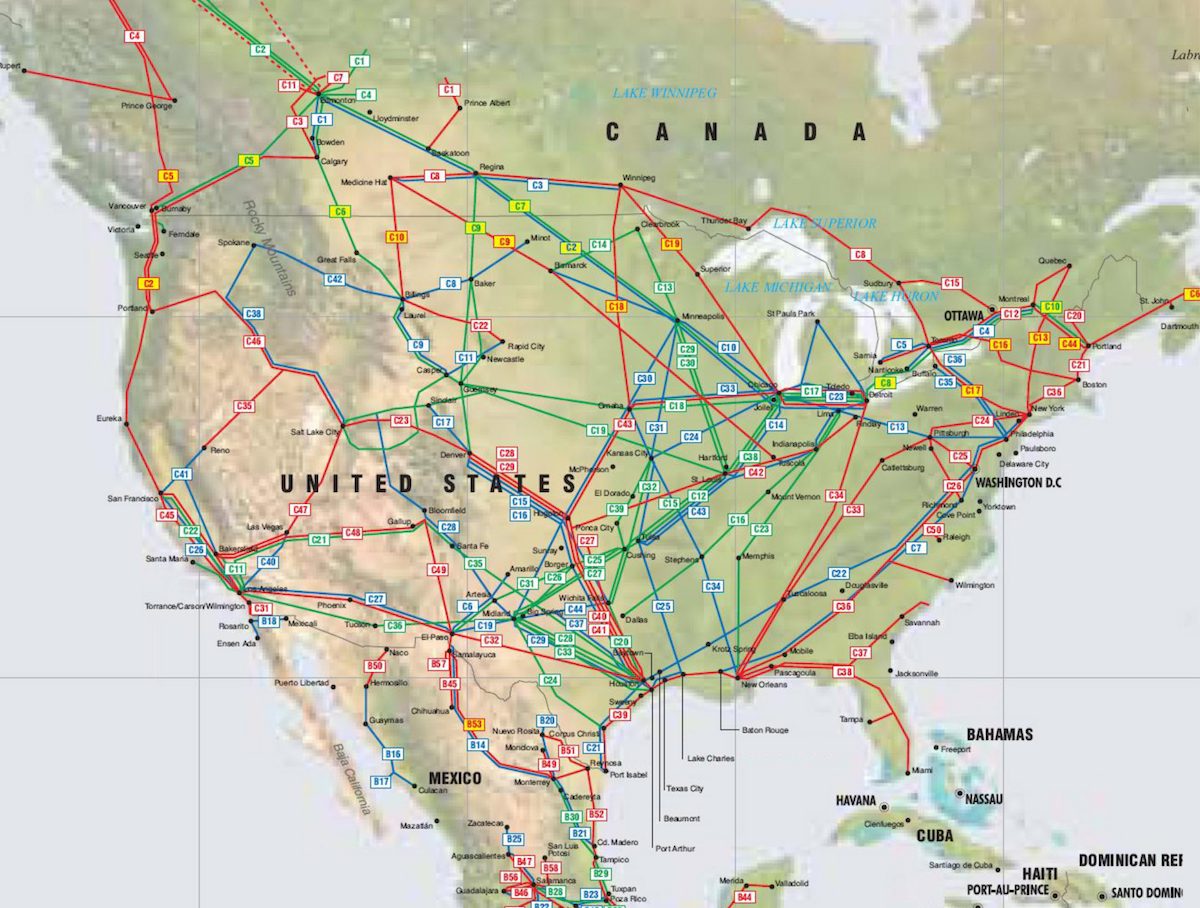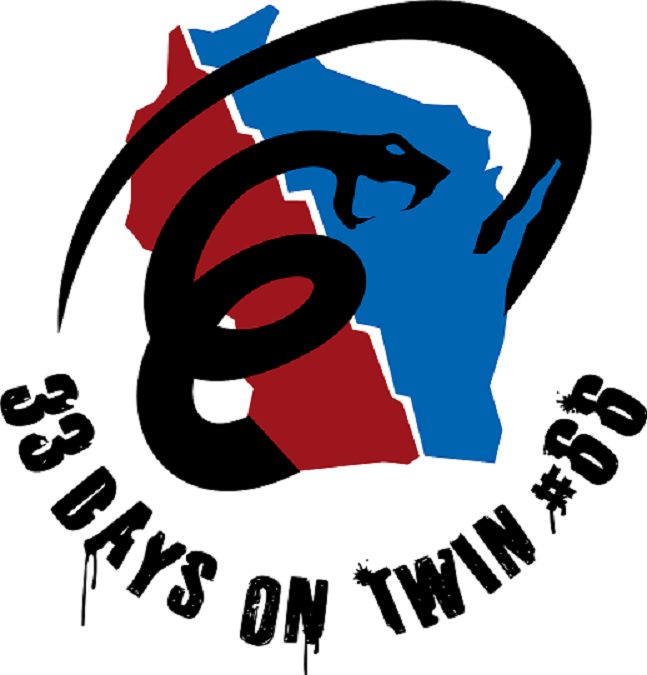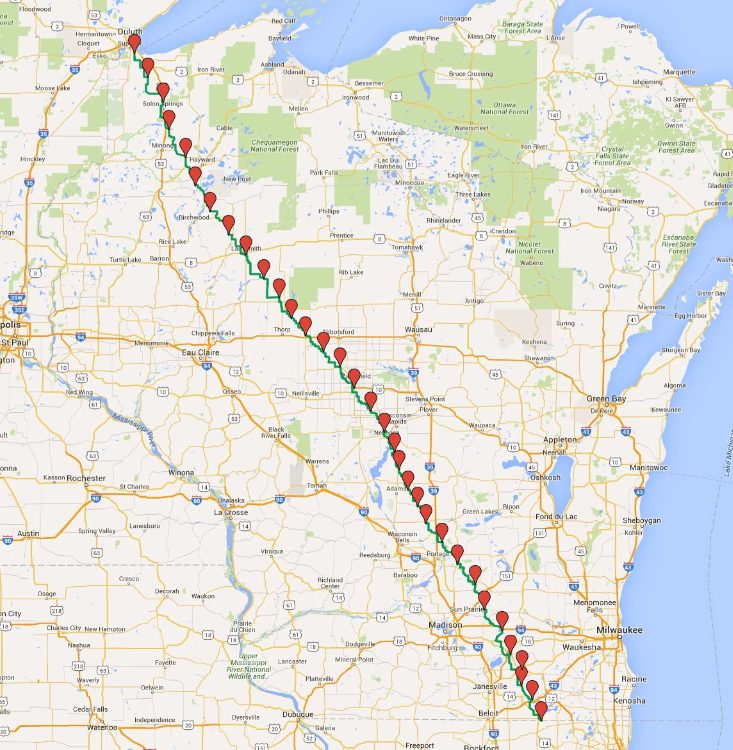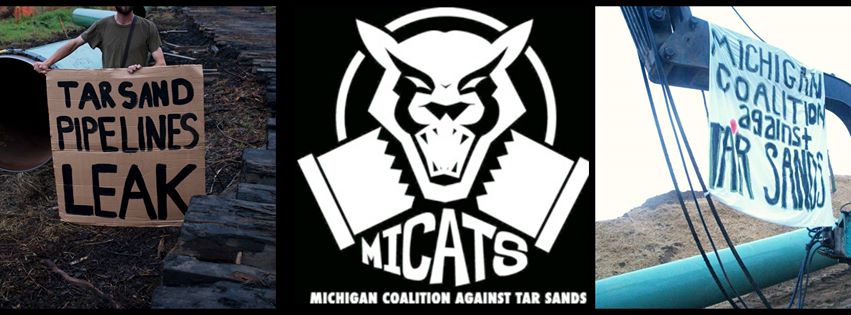
by DGR News Service | Jun 15, 2019 | Mining & Drilling
Editors note: this piece is nearly 8 years old, and as such some of the statistics are out-of-date. Nonetheless, it’s a valuable primer on North American pipeline infrastructure. Republished with permission.
By Ben Jervey / Desmog Blog / July 28, 2011
Over the next couple of weeks, I’m going to be rolling out a whole lot of information about pipelines. Why?
Because these metal tubes are truly the blood vessels of the oil and gas industry. Without them, the industry wouldn’t be able to deliver the liquid fossil fuels to their refineries, or out to the customers after that. Technically, it could be done with trucks and trains and tankers, but the economics just wouldn’t work. Without pipelines, liquid fossil fuels become impractically expensive.
(Note: you can find all of the posts in the pipeline series with the “pipeline” tag, or by following the links at the bottom of my post.)
So through one lens, pipelines are incredible. They cart valuable petroleum products from source to refinery to end use with remarkable efficiency. And they do so really cheap!
But not all is so rosy with these tools of fossil energy infrastructure. Pipelines leak and spill – pretty often, actually. They run through fragile ecosystems, under waterways, and across incredibly valuable aquifers. And as crucial as they are in delivering affordable fuel to your gas tank or furnace, they’re pretty tempting targets for anyone who wants to deal our nation’s energy supply a serious blow. In other words, our dependance on oil and gas pipelines makes our nation vulnerable to a terrorist attack, a concern that’s been long established in security circles.
Pipelines are typically built and paid for by private companies. But public support is crucial to the industry, and it comes in many forms, from eminent domain takings to subsidies and tax breaks to favorable environmental impact reviews.
You typically don’t hear much about pipelines, unless something goes wrong. And even then, hearing something about them is rare.
So let’s start at the top, and explain the very nature of pipelines: what kinds there are, what functions they serve, and where they run.
Types of pipelines
In general, there are two main types of energy pipelines: oil pipelines and natural gas pipelines. For now, I’m going to focus on those that carry oil.
For the oil industry category, there are pipelines that carry crude and others that carry refined petroleum products. If you’ll allow me to expand the blood vessel metaphor, crude pipelines are technically the veins that carry crude oil from the source to refineries. Just like our veins, they get thicker as they get closer to the spot they dump their contents out. “Gathering lines,” typically about 8 to 24 inches in diameter, collect oil from wells and then hook up into larger “trunk lines” that carry the crude over long distances to the refineries. The famous Trans-Alaska Pipeline System (TAPS), a trunk line, is probably the most well-known American pipeline, and it’s a full 48 inches in diameter.
In all, there are roughly 55,000 miles of these thick crude oil trunk lines in the United States.
Refined product lines carry the end products of the oil industry – gasoline, jet fuel, home heating oil, diesel fuel, and so on. These stretch across nearly every American state (with a couple of exceptions in crowded New England), and in all, there are thought to be about 95,000 miles of refined product pipelines.
Where are they?
The first question that probably jumps to mind is: are there any near me? For crude oil, it’s actually not so easy to find out. Official natural gas pipeline maps are out there, like this one from the Energy Information Agency.

But for security reasons, official government websites don’t publish the locations of crude lines. On private company’s sites you can find some not-so-detailed maps. Like this one from Canada’s Centre for Energy.

But by far the most comprehensive map I was able to find came from an interesting site called Theodora, an information publishing site that gathered lots of data from primary sources and mashed it up into this impressive map. Green lines are oil pipelines, red carry natural gas, and blue carry refined petroleum products.
Here is the larger map of North America:

And here is a closer look at the U.S. pipeline system:

You can see how a bunch of big red “trunk lines” come down from Canada and Alaska, funneling crude to refineries in California and the coasts of Texas and Louisiana.

by DGR News Service | May 21, 2019 | Direct Action
Editor’s Note: This zine is an excellent read, and we encourage you to study it thoroughly. However, we’d also like to point out that the fossil fuel industry is not dying—it’s unfortunately very robust and growing. We say this only because our strategies must be based on realism, and our realism leads us past non-violent direct action to Decisive Ecological Warfare.
Intro to Swarm
The Earth is gasping for air and so are all the living beings on her. The tightest knots around our throats are black snakes, the pipe-lines that pulse out of the oil fields in Alberta carrying climate-killing carbon across land and water. The fights against these pipelines em-body a series of battles in the war for the future of life on this planet: The Tar Sands Blockade. Standing Rock. Unis’tot’en Camp. L’eau Est La Vie Camp. These are places we have made our stands against annihilation. But the battle goes beyond these camps. This is a fight for every one of our futures, and defeat is not an option.
Through hard fought struggle, we have forged and sharpened our tactics in order to adapt and win. This zine has been written and edited by a number of frontline veterans in the climate struggle, hoping to address new concepts around how we fight those who would drive us to extinction. Specifically, we wish to introduce the concept of swarming and the strategy of roving caravans, using the Mississippi Stand campaign as a case study.
Swarm tactics are the use of autonomously-acting cells on the battlefield, acting in coordination without a centralized or hierarchical command structure. This way of carrying out actions mimics swarms in nature, such as bees or piranhas. Humans have used swarm tactics for thousands of years, especially for guerrilla and insurgent forces facing better-funded occupying forces.
The mobile caravan tactic takes the analysis of the pipeline fight as an asymmetric, “guerrilla” struggle against an occupying force to its logical next step. Rather than relying solely on stationary camps set up to block a pipeline, the mobile caravan approach relies on disrupting production up and down the pipeline, stretching police and security forces thin and maximizing disruption.
We aim to bring these ideas into the consciousness of the broader movement for discussion, debate, and subsequent application in the field. This zine has been written in the context of the brewing Line 3 struggle across Ojibwe and Dakota lands and the watersheds of northern Minnesota. However, we believe that the lessons we explore here and the experiences we gain through struggle will find relevance well beyond this particular pipeline fight. We believe that if adopted, these tactics can significantly increase the effectiveness of our struggles against fossil fuel infrastructure.
Read the full zine here: https://conflictmnfiles.blackblogs.org/wp-content/uploads/sites/409/2019/04/Swarm-READ.pdf

by Deep Green Resistance News Service | Nov 20, 2017 | Obstruction & Occupation
by Makwa Initiative Line 3 Front Line Resistance
Early Wednesday morning water protectors from Camp Makwa stormed an Enbridge construction site, and delayed progress on the last unfinished Wisconsin segment of their proposed line 3 pipeline project. One individual from the Diné Nation descended into the muddy trench, climbed onto the pipe, and locked himself to welding equipment. A Leech Lake Tribal member then climbed atop an excavator and attached himself to a hydraulic arm. Construction was halted for approximately six hours, costing the company thousands of dollars, as the individuals put their bodies on the line to protect the water and the futures of their children.
See the video here
Later in the day two more water protectors were arrested, while standing on the side of the public road. They were both tackled to the ground by Sergeant Kirchhoff of the Superior Police Department. For one of the arrests, when asked on what grounds he was acting, officer Kirchhoff cited a warrant that he could not produce. Later investigation found that the warrant he cited was unsigned and improperly filed. Last Week Sergeant Kirchhoff received media attention for tackling a woman to the ground without warning at a similar protest. The woman’s charges were later dropped.
The Enbridge Line 3 Replacement Project is estimated to carry almost one million barrels of tar sands oil from Alberta, Canada to Superior, Wisconsin; Enbridge has received approval in Wisconsin, but has not received approval in Minnesota, which would be the largest segment of the proposed project. The non-violent direct action came after a week of evidentiary hearings in Minnesota, where Enbridge revealed that it had already paid for 100% of the pipe for the project. The same day as the action it was discovered that before her time in public office Judge Ann C O’Reilly, the individual in charge of holding public hearings on the Line 3 Project, worked for a firm that represented oil companies on multiple occasions.
One water protector stated “Enbridge doesn’t have their permits for Minnesota and they have already started chopping trees down for their easement and filling its pipe storage yards. We went to the public hearings and found them full to the brim with Enbridge employees who were paid to be there. We fought again and again just to have 3 minutes to speak. Now we watch as truck after truck come into our communities carrying pipes and out of state pipeline workers. We made our comments, but they didn’t listen. The project is already bringing violence to our land and our women and children. We know that with these man camps comes increased levels of drugs, rape, and missing and murdered indigenous women. Enbridge will not take no for an answer so we have to stop them. We want to make clear in no uncertain terms, Enbridge is not welcome in Minnesota.”
Donate to Camp Makwa-
Camp Supplies: youcaring.com/makwacampsupplies
Legal Fund: youcaring.com/makwalegal

by Deep Green Resistance News Service | May 22, 2016 | ACTION, Protests & Symbolic Acts
By Sacred Water Sacred Land
Sacred Water Sacred Land is sponsoring a tar sands awareness walk through Wisconsin along Enbridge’s proposed Twin Line #66 starting with a kick-off event in Delevan or Walworth on June 8th.
33 Days on Twin #66, a Sacred Water Sacred Land sponsored walk, begins at the entry point of the Enbridge pipeline system, just south of Walworth, WI and follows the route northwest to Superior, raising awareness about the existence of, and proposed expansion to, the Enbridge crude and dilbit pipeline corridor along the way.
33 Days on Twin#66 will consist of consecutive daily 10-15 mile segments with community engagement talks in a revival type setting at overnight encampments at many points along the way. The 420-mile pipeline route is broken into four major sections: northern, upper central, lower central and lower.
Winona La Duke, who has fought tirelessly against the Sandpiper expansion in Minnesota, and her sister Lorna, will be riding with us on horseback along several sections of the walk.
Affected communities and landowners will be engaged by representatives of SWSL – Sacred Water Sacred Land, CELDF – Community Environmental Defense Fund, and WiSE – Wisconsin Safe Energy Alliance, through an ecological forum where the impact of the expansion and a broader conversation about the adverse effects of Canadian tar sands extraction and transport will be explained. Guest speakers will also address climate change and traditional ties to the land while local residents will be encouraged to share their stories and efforts towards healing it.
Through this effort, SWSL endeavors to not only draw attention to the tremendous hazards of tar sands/Bakken oil transport but also help communities imagine and co-create a more sustainable, health conscious society with an emphasis on renewables and non-toxic food systems.
We are looking for additional sponsors to lend credence and build support for the Walk. Sponsorship is welcome in many forms. We encourage you to share the Walk with your membership and follow us on Facebook where specific details will be posted as they solidify. If you wish to participate in greater measure, please contact SWSL directly.
It is past time to unify our efforts and promulgate ecological systems literacy. We hope you will join us as we work together towards a paradigm shift of social and environmental justice for the natural world and the next seven generations.
Cosponsored by WiSE, CELDF, and SWSL

Schedule:
1 ~ June 8th – Walworth*, Kick-off!
2 ~ June 9th – Delavan*
3 ~ June 10th – Richmond
4 ~ June 11th – Whitewater*
5 ~ June 12th – Fort Atkinson*
6 ~ June 13th – Lake Mills*
7 ~ June 14th – Sun Prairie*
8 ~ June 15th – Columbus*
9 ~ June 16th – Wyocena
10 ~ June 17th -Portage*
11 ~ June 18th – Oxford*
12 ~ June 19th -Westfield
13 ~ June 2oth – Adams/Friendship*
14 ~ June 21st – Cottonville
15~ June 22nd – Lake Arrowhead
16 ~ June 23rd – Nekoosa*
17 ~ June 24th – Vesper
18 ~ June 25th – Marshfield*
19 ~ June 26th – Spencer
20 ~ June 27th – Riplinger
21 ~ June 28th – Owen/Withee*
22 ~ June 29th – Lublin
23 ~ July 30th – Gilman
24 ~ July 1st – Sheldon
25 ~ July 2nd – Ladysmith*
26 ~ July 3rd – Imalone
27 ~ July 4th – Meteor
28 ~ July 5th – Hauer-Stone Lake
29 ~ July 6th – Hayward
30 ~ July 7th – Gordon*
31 ~ July 8th – Salon Springs
32 ~ July 9th – Hillcrest
33 ~ July 10th – Superior*, Renewable Energy Independence Day!
* Denotes Revival

by Deep Green Resistance News Service | Dec 12, 2013 | Toxification
By Michigan Coalition Against Tar Sands (MI-CATS)
BATTLE CREEK, Noon, on December 13th:
After activist and Kalamazoo resident Chris Wahmhoff’s felony pretrial, Michigan Coalition Against Tar Sands (MI-CATS) will hold a press conference to raise awareness about chemical oil dispersants found in the Kalamazoo River. Earlier this year Chris protested Enbridge Energy by skateboarding into their pipeline and stopping construction. He was charged with resisting and obstructing an officer and faces 2 years in prison.
Scientists and residents are questioning how chemicals shockingly similar to those used in the BP Deepwater Horizon gulf oil spill, and Exxon Valdez tanker spill disasters, would end up in the Kalamazoo River from Marshall, Michigan to more than 40 miles downriver. In the aftermath of the 2010 Kalamazoo oil spill Enbridge was fined for each gallon of oil recovered. Chemical dispersant breaks up oil into unrecoverable particles. Both Enbridge and the EPA have denied that any dispersants were used.
However, since August, samples collected from the Kalamazoo River have been analyzed and found to contain chemical signatures similar to Corexit 9527, Corexit 9727A, and Corexit 9500. Corexit 9527, 9727A, 9500 are rare and are ingredients in a group of chemical oil dispersants marketed as Corexit. Corexit was used in the BP oil spill and has had carcinogenic, respiratory, and hemorrhaging effects on residents, clean-up workers, and wildlife. Calhoun County residents are experiencing these same toxicity
issues. Senior Policy analyst at the EPA, Hugh Kaufman has found effects of Corexit to be worse than the oil spill itself. Studies by a group of local and national scientists and doctors are confirming our suspicions- that chemicals dispersants or surfactants were used to hide the severity
of the 2010 tar sands oil spill.
Resident Michelle Barlond Smith, who conducted health surveys along the spill area, along with several residents along the river, reported that dump trucks would drive up to the river and dump truck loads of material into the water. We are questioning the safety of the river and the water due to these chemicals. We are concerned about human and animal health, and demanding a health study contrary to Michigan Department of Community Health’s and Calhoun County Health Officials and Agency for Toxic Substances and Disease Registry.
Join us. S River Rd, Battle Creek, MI 49014. 12:00 Noon, December 13th.
Question and answer session with scientists & activists to follow, at 4785
Beckley Rd, Battle Creek, MI 49015










